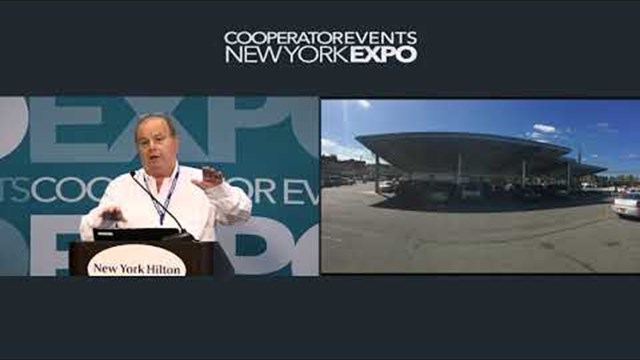
These days, it seems like everybody is looking to 'go green.' The term is shorthand for a movement of environmental awareness that involves everything from the way architects design new buildings and homes to the ways co-ops, condos and HOAs recycle their waste. In other words, green means to help the environment by reducing the amount of energy you use.
That’s why savvy boards and property managers are not only implementing the little things—such as turning down thermostats, shutting off air conditioners, and turning out lights in common areas when not in use—but investing in more substantial technology and greener equipment that uses less energy.
Let’s take a look at how New York City co-op and condo buildings are going green.
Green Houses
Bill Footer, senior program director for Massachusetts-based Conservation Services Group, which handles National Grid’s multifamily program, says the interest in condos becoming green has increased greatly over the last few years. “It seems a lot of communities these days have a green committee that will look for ways to decrease expenses,” he says. “They're concerned about energy use and want to do whatever they can.” And that, says Footer, is where his organization comes in. “We can help them reduce common area energy usage as well as in-unit energy usage.”
The question has always been, is it economically viable? “For a co-op, condo or building owner, the investment in ‘green’ improvements can easily build momentum when it is economically viable—and even more so when it results in a much more healthy and attractive living environment,” says Ivan Brice, AIA, principal and founder of Ivan Brice Architecture in New York City.
“Since the majority of buildings in New York City are showing their age, every act of properly maintaining, repairing and restoring an old building is inherently ‘green’ whether or not it is labeled as such. We often find that simply improving or replacing older components can generate the gains most buildings are seeking. When it comes time for major window or roof replacement, durability and thermal efficiency are the top priority,” he says.
Surging numbers notwithstanding however, the green movement isn't universal—and part of that has to do with demographics and community mindset, says Charles W. Southard, Jr., a Smith Point, Long Island-based architect and former condo board president.
Money Talks
“Most condo boards are only interested in becoming more ‘green’ if there is a financial benefit to the community. Condos are comprised of multiple owners, some of whom believe in being green for the sake of the environment at whatever cost—and some who are just concerned about the monthly expense. The owners vote for improvements and a large number are needed to approve any expenditure of new money.”
“In our work with co-ops and condos relating to exterior restoration and preservation,” says Michael Granville, R.A. of Darius Toraby Architects in New York City, “we have found boards and owners to be only intermittently interested in going green. But developers are another story. Many developers we work with have a serious commitment to sustainability, and make sure their projects follow green building paths, whether Leadership in Energy and Environmental Design (LEED) or more stringent internal standards.”
So, it seems a majority of new residential buildings factor in environmental concerns into its design. This includes everything from building materials and solar power to the direction the front door faces.
Everything Old is New…
While more common in new construction, new technologies are nevertheless being integrated into existing condos and co-ops with a view to cutting energy use and reducing the carbon footprint of these residential communities.
“Advances are always being made in mechanical, electrical and plumbing technologies affecting heating and air conditioning systems and their controls,” says Brice. “Boiler controls, cogeneration, solar flow fixtures, Energy Star appliances are all examples of improved technology. Far less known or discussed are advances in architectural materials and detailing that may benefit a renovation project. By using more durable materials combined with newer flashing methods, adequate expansion joints, vapor and air barriers and mold resistant sheathing, the repair of a building will have a much greater expected life.”
“Condo boards control the common areas of the properties,” adds Southard, and they can make greener choices about those spaces. “Site and exterior lighting, lawns and landscaping, roadways, common buildings, pool and trash” can all be managed in more environmentally-friendly, energy-saving ways. In more suburban neighborhoods, “lawns can be watered using impounded rainwater from their collection system ponds and drainage basins. Lawns can have the amount of fertilization reduced, which results in fewer cuttings. Roadways can be resurfaced by removing the existing asphalt, reheating it and reinstalling it. Pools can be heated using solar water heaters and trash can be separated to reduce costs.”
Be More Efficient
“Many of the mechanical, electrical and plumbing system technologies have been proven over the years,” says Edward H. Brzezowski, PE, LEED AP, vice president of Energy/MEP Services for The Falcon Group with offices in New York City, New Jersey and nationwide. “New boilers, chillers, cooling towers, air handling units, pumps, controls and lighting continue to become more efficient—and now they provide network connectivity... via a web browser under secure remote access, so you can see how they are performing.”
And, adds Brice, “The best thing a board can do is to engage the appropriate professional to conduct a physical assessment of the property. This enables you to establish your building’s deficiencies and assets, and identify where there is potential to have the greatest impact—without neglecting your most pressing needs and priorities. The firm you hire should be one that understands and has focused on existing buildings.” He notes that all licensed architects and engineers in New York State are required to comply with the New York State Energy Conservation Code. And, he says, if you are considering a green roof, you will want to employ an architect who is a certified green roof professional.
The Light Stuff
Lighting is becoming somewhat of a low-hanging fruit type of priority. Replacing common area lighting with light-emitting diode (LED) lighting can be very cost-effective over the long term. “Boards are expressing curiosity about larger infrastructure projects,” says Granville, “but generally these projects are down the list, behind other improvement projects like façade repairs, new roof, elevator renovations and lobby renovations.”
“One of the easiest and cheapest things boards can do to go green is to replace lighting with LED lighting,” says Southard. The traditional “Edison” incandescent light bulb was of course a quantum leap forward from the use of candles, yet only 30 percent of the energy used by incandescent went toward the production of light; 70 percent was wasted as heat energy.
The newest generation of solid-state lighting lasts up to 25 times longer than a standard incandescent bulb and saves up to 80 percent more energy in comparison. Replacing common area lighting with LED bulbs can prove to be cost effective over the long run by reducing both operating and maintenance costs.
Granville agrees with Southard that LED lighting is the way to go. “LED lighting is cracking the market,” he says, “And more and more boards are deciding to use them in their common areas.”
According to Footer, the latest technology National Grid has utilized is LED lighting in condos, but they are also seeing an increase in helping condos switch to energy-efficient refrigerators. “If they qualify, we offer people rebates to buy an Energy Star refrigerator ($150 rebate), which offsets the cost of going from standard to Energy Star,” he says. “We also offer help with showerheads and offer incentives for programmable thermostats.”
Additional Resources
There are a number of resources to which boards can turn to in their quest for greenness. For example, start with PlaNYC, says Brice, the city’s long-term vision to increase sustainability for a greener, greater New York.
“The New York City Department of Buildings (DOB) has some great resources available through their website in conjunction with PlaNYC,” says Brice. “To meet the city’s goal of reducing greenhouse emissions by 30 percent by 2030, the New York City Energy Conservation Code (NYCECC) sets energy-efficiency standards for new construction and alterations to existing buildings. Con Edison offers assistance through its website at www.coned/energyefficiency.com. The New York State Energy Research and Development Authority (NYSERDA) is a good resource—their website address is www.nyserda.ny.gov and the United States Green Building Council (USBC) is always a good source.”
Additionally, “there are local utility companies which offer assistance in green energy,” adds Southard. The board, property managers and the owners need to be willing to invest time and a little money to go to seminars. They should also take courses and research what is available.”
“Every little bit of savings each day can accumulate into very significant savings over the course of the year,” says Brzezowski. “Buildings and systems are aging so we have the opportunity to deal with deferred maintenance, renovation and modernization needs as they arise. Superstorm Sandy has increased the awareness of critical life safety and convenience/comfort systems that should also be connected to emergency generators. This has also led to interest in combined heat power systems.”
In short, green is this year’s color and will be the color of choice for the foreseeable future. As more money, time and research are invested in green technologies the Greater New York metropolitan region will soon be even greener than it already is.
Christy Smith-Sloman is a staff writer at The Cooperator. Freelance writer Keith Loria contributed to this article.









Comments
Leave a Comment